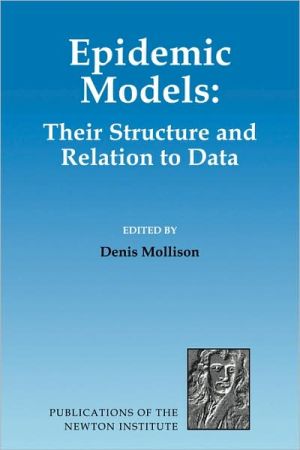

 |

|

Sold Out
Book Categories |
| Preface | ||
| Introduction | ||
| Contributors | ||
| Some problems in the theory of infectious disease transmission and control | 3 | |
| The structure of epidemic models | 17 | |
| Coupling methods in epidemic theory | 34 | |
| Collective epidemic processes: a general modelling approach to the final outcome of SIR epidemics | 53 | |
| The threshold concept in deterministic and stochastic models | 71 | |
| How does transmission of infection depend on population size? | 84 | |
| The legacy of Kermack and McKendrick | 95 | |
| Incorporating spatial components into models of epidemic spread | 119 | |
| Velocities of epidemic spread | 150 | |
| Spatial epidemic models | 187 | |
| A perturbation approach to nonlinear deterministic epidemic waves | 202 | |
| Epidemic plant diseases: a stochastic model of leaf and stem lesion | 215 | |
| Detecting nonlinearity and chaos in epidemic data | 229 | |
| Seasonality, demography and the dynamics of measles in developed countries | 248 | |
| Grouping in population models | 271 | |
| Core groups and R[subscript 0]s for subgroups in heterogeneous SIS and SI models | 279 | |
| Data driven network models for the spread of disease | 302 | |
| The effect of antigenic diversity on endemic prevalence | 323 | |
| Statistical challenges of epidemic data | 339 | |
| Primary components of epidemic data | 339 | |
| Primary components of epidemic models | 350 | |
| Estimation and prediction in tropical disease control: the example of onchocerciasis | 372 | |
| Some current trends in estimating vaccine efficacy | 394 | |
| Operational modelling of HIV/AIDS to assist public health control | 404 | |
| Appendix: Problem areas | 417 |
Login|Complaints|Blog|Games|Digital Media|Souls|Obituary|Contact Us|FAQ
CAN'T FIND WHAT YOU'RE LOOKING FOR? CLICK HERE!!! X
 You must be logged in to add to WishlistX
 This item is in your Wish ListX
 This item is in your CollectionEpidemic Models: Their Structure and Relation to Data
X
 This Item is in Your InventoryEpidemic Models: Their Structure and Relation to Data
X
 You must be logged in to review the productsX
 X
 X

Add Epidemic Models: Their Structure and Relation to Data, Epidemiology is one of the most vibrant branches of applied ecology. Progress in this field requires inter-disciplinary collaboration; leading researchers with a wide range of mathematical expertise and close involvement in applied fields across the socia, Epidemic Models: Their Structure and Relation to Data to the inventory that you are selling on WonderClubX
 X

Add Epidemic Models: Their Structure and Relation to Data, Epidemiology is one of the most vibrant branches of applied ecology. Progress in this field requires inter-disciplinary collaboration; leading researchers with a wide range of mathematical expertise and close involvement in applied fields across the socia, Epidemic Models: Their Structure and Relation to Data to your collection on WonderClub |